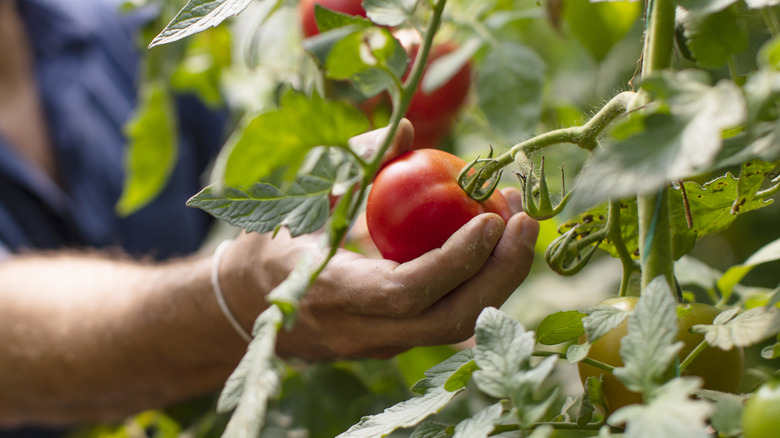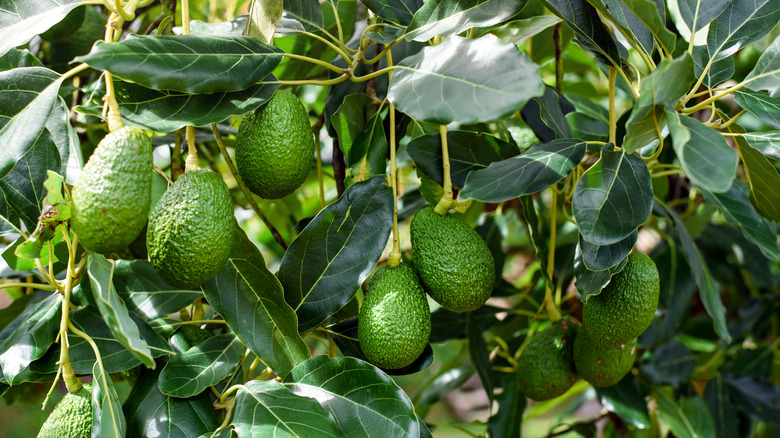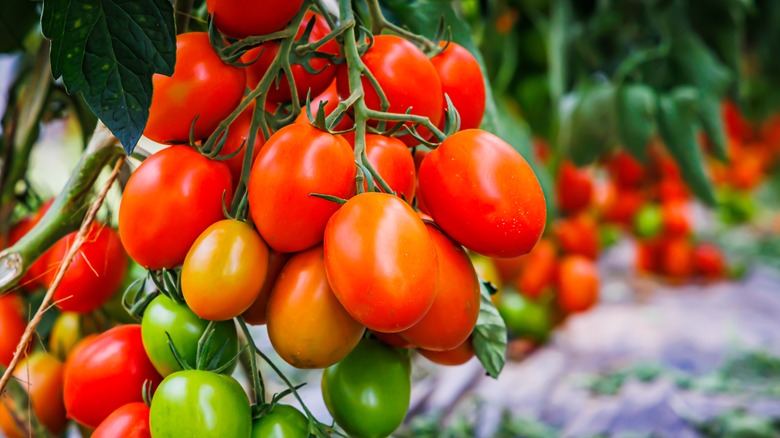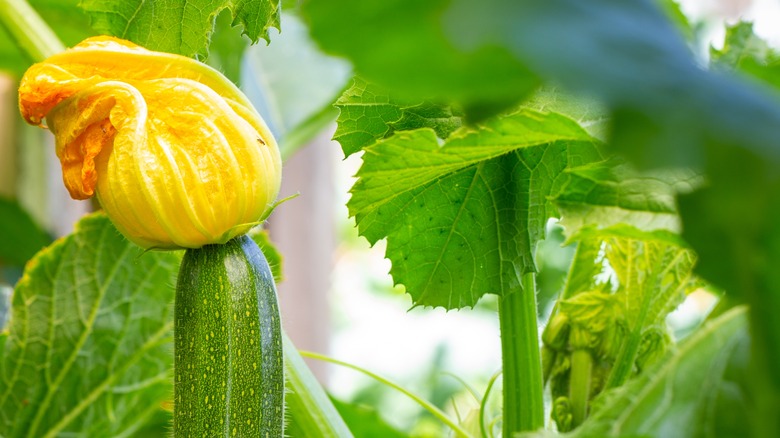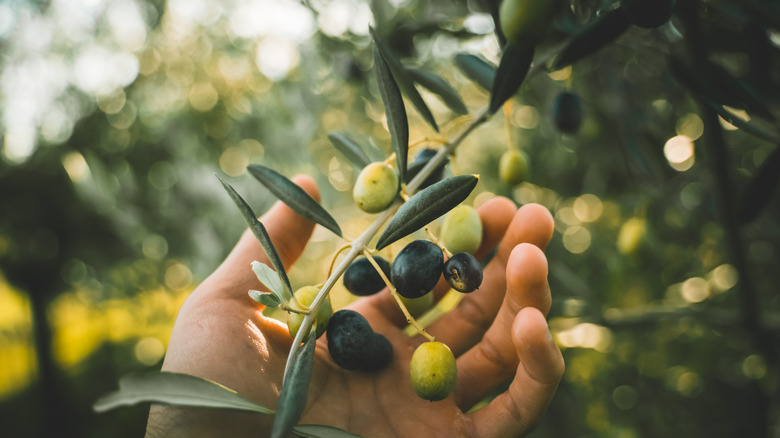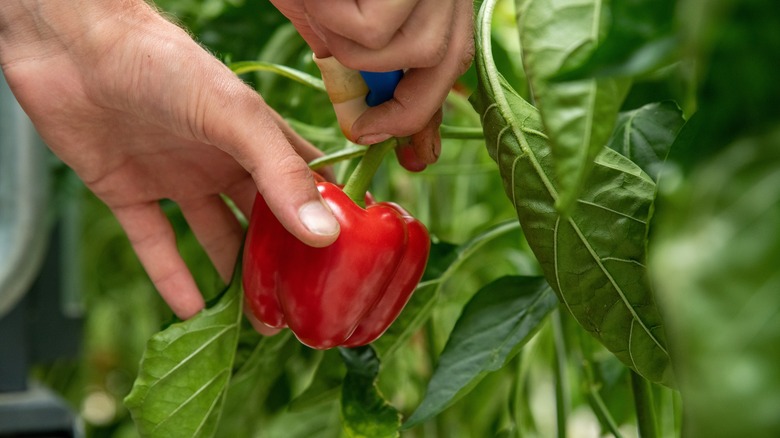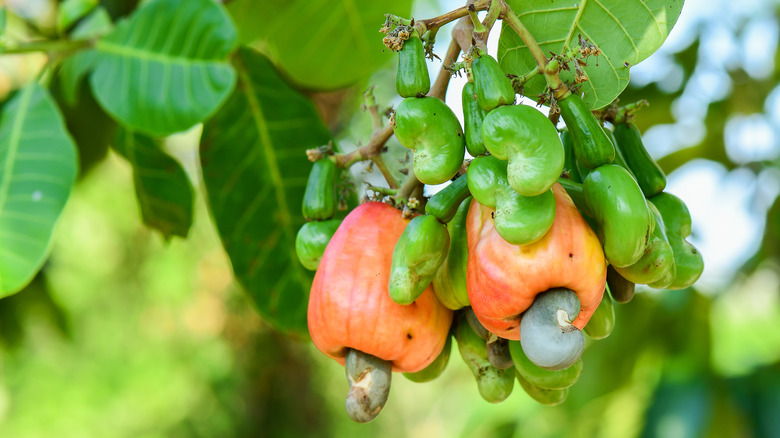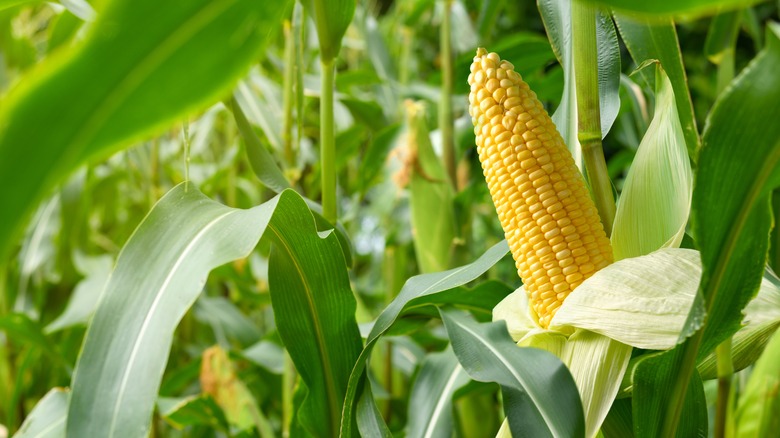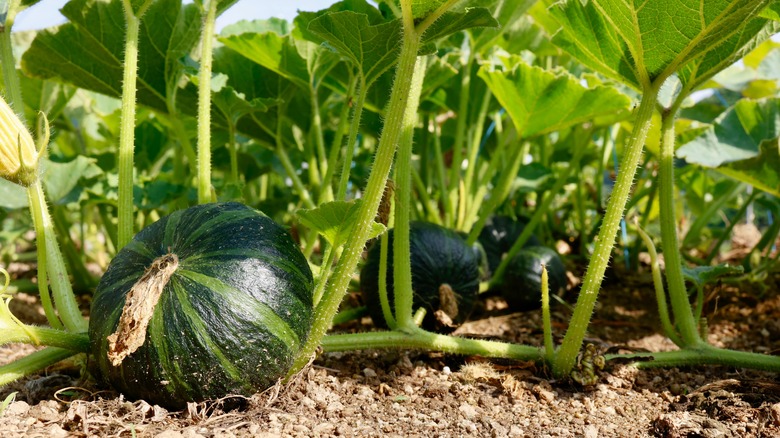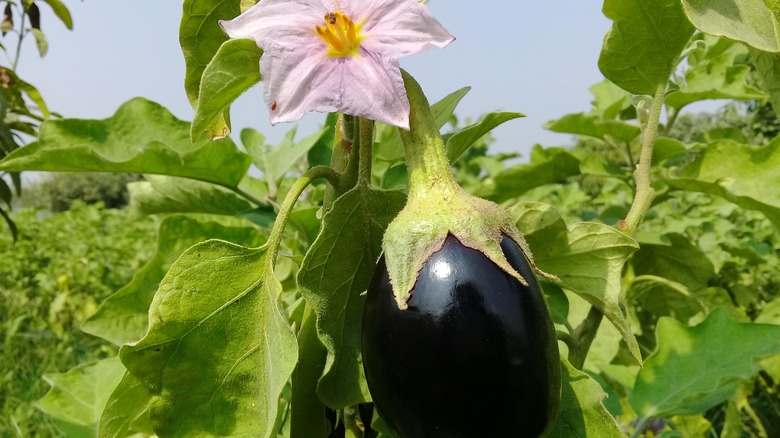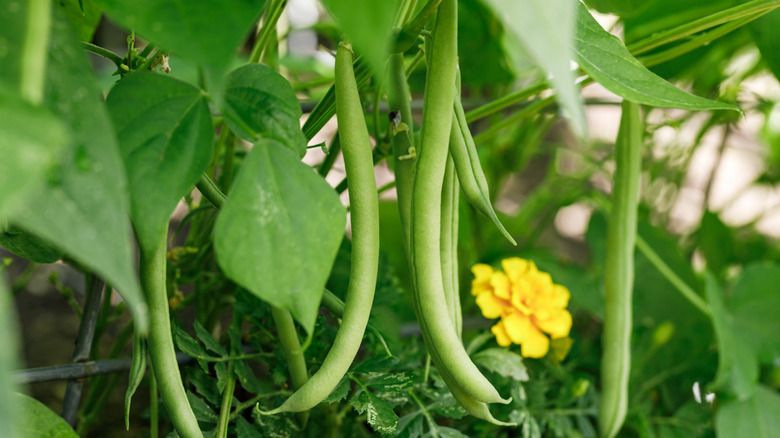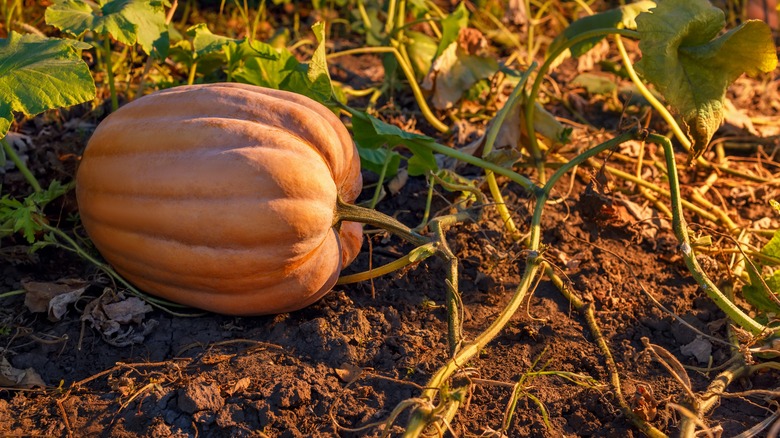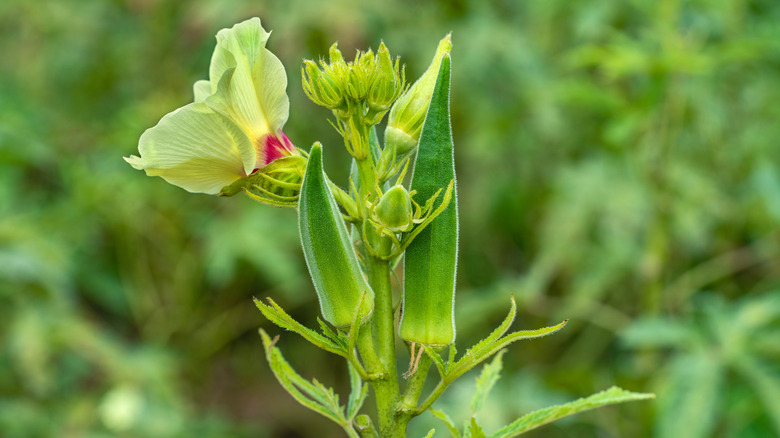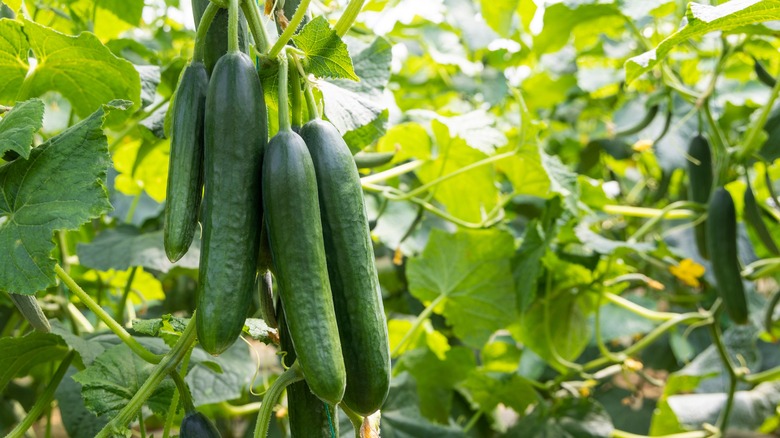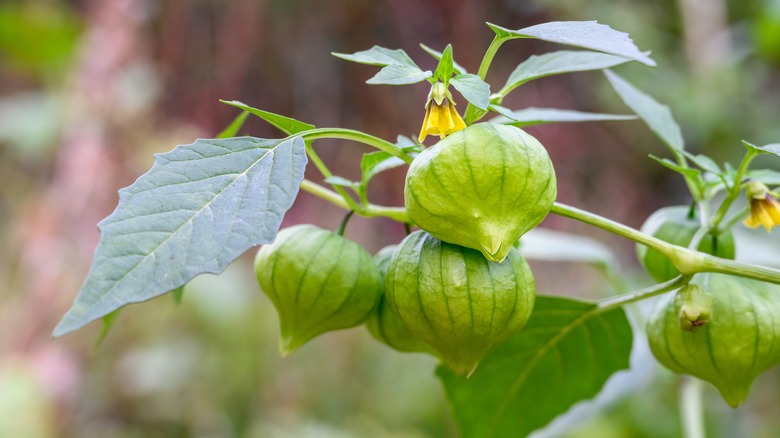14 Fruits That Are Commonly Mislabeled As Vegetables
While you may feel like you've had a tight grip on the difference between fruits and vegetables since the third grade, we're here to tell you that the reality of distinguishing the two is actually much more complicated than meets the eye. Lay terms might have you believe that any edible plant that's sweet and juicy is a fruit, and those with a more neutral flavor and a crunch are vegetables. But for botanists, it goes way beyond taste. This is why many fruits are commonly mislabeled as vegetables and vice versa.
There are a few important distinguishing factors between fruits and veggies, one of them being that fruits always come from a flower. You'll notice that blossoms often open and die before a fruit takes its place. In addition, fruits also always contain at least one seed that is fertilized and can be used to regrow a new plant. Vegetables, on the other hand, cover any edible part of a plant from the leaves to the roots. Because this distinction has us rethinking what's a fruit, and what's a vegetable, we've listed out fruits that are often confused for vegetables to set the record straight.
Avocados
Avocados are all the rage and have been increasing steadily in popularity as a healthy, plant-based fat. They make the perfect topping for Mexican dishes, Buddha bowls, and toast, but recently avocado fans have been getting creative. Avocado frosting and avocado smoothies have been making a name for themselves, and the results have been quite delicious. This versatility only further proves that avocado, although labeled a vegetable by most of the world, is in fact a fruit that pairs beautifully with other fruits and can make quite a delicious dessert. If you want to experience the full range that this fruit has to offer, consider reading up on tips you need when cooking with avocado.
Avocados come from trees in tropical environments. These trees flower before producing the fruit, which is picked early and ripened off the vine. If you're someone who enjoys those mushy green fruits, then you know just how temperamental they can be. Once you learn how to pick ripe avocados from the grocery store, your life will drastically improve. Because of their neutral flavor and green appearance, it's no wonder avocados are often mistaken as vegetables.
Tomatoes
Tomatoes have been infamous for catching people in their fruit and veggie confusion, so you may already know that although tomatoes are mostly used in savory dishes, they are indeed a fruit. While tomatoes are most often found in salads, marinara, and pizza sauces and are commonly diced in curries, salsas, and casseroles, they also pair beautifully with fruits like watermelon and peaches.
Tomatoes are a popular pick among gardeners, not only because there is nothing better than a fresh tomato, but also because they are relatively easy to grow. Growing your own tomatoes also translates into savings at the grocery store. If you have a green thumb and have grown the fruit from scratch, then you're well aware of the beautiful tiny flowers that tomatoes produce. There are a variety of tomatoes that range in color, sweetness, and even texture. While cherry tomatoes are often found in salads, for example, heirlooms are typically sliced raw and eaten with a little olive oil, balsamic, or even mayonnaise.
Zucchini
While you may have had an inkling that avocados and tomatoes were fruits masquerading around as vegetables, you may be surprised to hear about zucchini's true identity. Zucchini, in all its glory, truly does look and taste like a vegetable. It's mild, not sweet, crunchy, and typically green or yellow. It's rarely found paired with fruit, and other than zucchini bread, it would never likely be served in dessert form. However, if you've been lucky enough to see a zucchini plant in action, then you know it has a big, beautiful, blossoming flower from where the long fruit grows. In fact, zucchini blossoms are edible and are often served stuffed with soft cheese, battered, and delicately fried.
Those blossoms, along with the soft seeds found in zucchini, are both indicators that zucchini, however savory, is actually a fruit. And a versatile one at that. There are plenty of creative ways you can use your summer zucchini harvest to make dishes that range from fritters to chips. And while zucchini may seem like the bland plant that replaced your pasta, it has endless potential for culinary creatives.
Olives
Olives seem to be one of those foods that we love eating but don't know too much about. And although it's common knowledge that olives grow on trees, many people have never actually seen or eaten a raw olive before. There is quite a process olives go through after they've been harvested and before they reach grocery store shelves. The reason for this is that freshly picked olives are quite bitter and inedible because of their flavor. This is the reason why you'll never see fresh olives at the grocery store. They must go through a process of either soaking in brine for a minimum of six months or lye for a shorter period of time or be air- or salt-cured. And when it comes to categorizing these tiny nuggets of flavor, it's apparent they are fruits because olive trees blossom, and their pits are in fact seeds.
While olives are not actually salty by nature, they do have a fatty yet refreshing, almost floral flavor. Olives, like avocados, are yet another fruit that contains healthy, unsaturated plant-based fat without cholesterol.
Peppers
When it comes to categorizing peppers as a fruit or vegetable, they seem to have qualities that fit into each category. Veggies are often crunchy, and crispy, just like bell peppers. Fruits are sweet, colorful, and loaded with vitamin C just like bell peppers, too. But because peppers grow from a flower and contain fertilized seeds, they are, indeed, a member of the fruit family. Furthermore, those four varieties of bell peppers we love so much — green, yellow, orange, and red — are actually all the same fruit in different stages of maturity.
While peppers may be a more believable fruit than, let's say, zucchini, it's true that they are commonly referred to as a vegetable. Peppers are most often used in savory dishes like stir-frys, tacos, and pasta sauces, and they are typically paired alongside other roasted vegetables. But bell peppers aren't the only peppery fruits out there. All hot peppers like jalapeños, chili peppers, and poblano peppers are fruits, too. Who would have guessed that you'd be heating up your dish with fiery fruit, or sprinkling hot fruit flakes on your entrée to spice things up? I guess jalapeño jam makes a little more sense when you have all of your facts.
Some nuts
We don't know about you, but we are still getting used to the fact that peanuts are legumes. Now, as it turns out, some of our favorite nuts are actually fruits, grown on trees from flowers. While it may seem like the whole world is turned upside down at this point, we might as well remind you that this means those plant-based nut milks you enjoy with your cereal every morning are technically watered-down fruit juice. Yum?
Some of your favorite snacking nuts like pistachios, cashews, and almonds aren't actually nuts. While you might be feeling little nuts right now reading this, they are classified as drupes, which are a kind of fruit that is quite fleshy with a hard casing. The part that we are actually eating is the seed, which can be consumed raw, roasted, or blended into butter ... which I guess we can call fruit paste. But don't worry about the technical classification because, unless you're talking to a botanist or fruit expert, most people follow the narrative that these fruits are nuts. They may even look at you like you have two heads if you call them otherwise. In culinary and nutrition terms, these are nuts, so why complicate things with the truth?
Corn
It's corn! While we've all heard the viral "Corn Song" describing "a big lump with knobs" that "has the juice," corn is a difficult food to categorize. People often get confused as to whether it's a fruit, a grain, or a vegetable. While corn will most commonly be referred to as a vegetable, we've all enjoyed corn meal as a grain, and of course, it's loaded with sugar like fruit. When all is said and done, it's best to turn to the professionals, in this case, botanists. They classify the universally loved cob of deliciousness as a fruit. This is because it's produced from the flower of the corn plant, and those little kernels we love so much are indeed seeds.
But just because corn is a fruit doesn't mean it needs to be enjoyed over pancakes or blended into your smoothie (is it just us, or do those odd combos not sound too bad?). Grilled corn on the cob is still one of the best cookout side dishes around, and corn is so flavorful it can be enjoyed without any kind of sauce or seasoning. If you do have a sweet tooth, cornbread, and even corn pudding are quite popular and feature the sweetness that spews from each bite.
Winter squash
We have finally wrapped our brains around summer squash being a fruit, but now we have to go one step further and accept winter squash into our lives as a fruit as well. These big gourds come from enormous beautiful flowers, and we know their seeds well, as they are edible and delicious when roasted. If you truly think about it, winter squash can be incredibly sweet like many fruits, and it is available in a variety of colors. And when it comes to variety, winter squash does more than cover the color palette. There are endless flavors, textures, and shapes out there.
Most winter squash can lean either sweet or savory, depending on how it is seasoned and prepared. Generally speaking, squash can be roasted after being sliced in half and cleaned of its seeds. You can go with a savory rub and douse with olive oil, salt, pepper, garlic powder, and hot pepper flakes. If your sweet tooth is calling out, try using honey or maple syrup along with olive oil or coconut oil and ginger. Why not do both? Mix garlic, maple syrup, salt, pepper, and hot pepper flakes for the ultimate savory sweet flavor.
Eggplant
Eggplant is one of those vegetables with a texture that you either hate or love. Or so we thought. It's actually a fruit, which makes your baba ghanoush more of a fruit paste than anything else. Even weirder, eggplant is categorized as a berry because of its small edible seeds. Eggplants are a bitter fruit that often needs to undergo some prep before it can be enjoyed, even if you plan on cooking it. Salt your eggplants first and allow them to sweat. This just means that some of the bitter moisture will rise to the surface that you can blot away with a paper towel before cooking the fruit.
These berries can be enjoyed in many cuisines and are popular in both Mediterranean and Asian dining. If you're vegetarian or vegan, eggplants can make a great replacement for steak on the grill or roasted in the oven if seasoned properly. Thinly sliced eggplant can even be made into vegan bacon when fried in oil with smoked paprika, maple syrup, garlic powder, black pepper, and tamari. Bacon berries — who would have thought?
Green beans
Green beans are the ultimate veggie side dish that can sneak their way onto even the pickiest of eater's plates. If someone, whether a child or an adult, just can't seem to stomach vegetables, then peas are a safe place to start. This may be because beans and peas are not vegetables at all but are actually fruits. Pea flowers are infamously beautiful, and of course, those little pods that are actually seeds are quite sweet and delicious. Green beans are mild in flavor, with a slightly earthy and sweet undertone. They can be eaten either raw or cooked.
If you're unsure where to start, try simply breaking off the rough ends and steaming the green beans. If you're feeling adventurous, try adding a little lemon juice and soy sauce, or even just salt and black pepper. It doesn't take much to make green beans sing, or peas for that matter. And although green beans could be the mascot for all veggies, they've been living a lie and are actually a fruit.
Pumpkin
While it may seem confusing to have so many fruits and veggies swapped in your mind, it's best to just stick with how the general public categorizes them and save these distinctions as fun facts for your next dinner party. Or maybe bring up the differences if the conversation dies on a first date. This is because the rest of the world functions as if these fruits are vegetables, so you'll just get mixed up at the grocery store if going with the technical categorization.
For instance, pumpkins are always found with vegetables, not fruits, although they are, indeed, fruits masquerading as veggies. Pumpkin flowers are quite beautiful and grow from vines that cover the earth with large leaves to keep the soil cool and damp. Their seeds, also referred to as pepitas, are delicious, and as we know, pumpkins can be quite sweet. Come pumpkin spice season, it won't take many conversations to assure anyone that pumpkins are fruits because they make their appearance almost exclusively in sweet dishes like pies, lattes, and muffins.
Okra
This slimy Southern vegetable, also known as lady's fingers, has an almost eggplant-like seedy texture. It can be served sautéed, deep-fried, and mixed into gumbo. For those who hate the sliminess, try the okra cooking method that has won over its haters. Simply slice the okra lengthwise instead of into little rounds as it's usually prepared. If that doesn't do it for you, and you've written off the vegetable entirely, it's time to rethink the entire concept in your head because okra is actually a fruit. Does that make the slimy texture more palatable?
Okra grows from a beautiful delicately yellow flower with a deep purple or pink center that could sneak its way into a wedding bouquet. And although its nickname is rather off-putting, the fruit doesn't taste like fingers at all (thank goodness) but instead is slightly sweet and grassy. It's versatile in the kitchen, and it is mainly found in Southern cuisine. But okra can be a fantastic addition to cultural dishes from all over the world.
Cucumbers
It makes sense that these watery, refreshing, tube-shaped veggies are actually a fruit. After all, we enjoy cucumbers sliced in water, they're juicy, and they have an almost floral flavor. It's even been claimed that when sprinkled with sugar, cucumbers taste like watermelon. This is because the two are from the same family, and they actually do have quite a few similarities in both flavor profiles and how they are grown.
While cucumbers are traditionally sliced, you should take your culinary skills up a notch and try smashing them instead. This helps to disrupt the structure of the fruit so it absorbs flavor more easily, like the dressing or seasoning it's enhanced with.
For pickle lovers, this may come as quite a shock because pickling a fruit could seem like an odd concept. And when it comes to adding those tangy vinegar-soaked slices to burgers and sandwiches, the idea may seem even more disorienting. But think of it this way: Because cucumbers are technically a fruit, it's a great way to get your recommended servings of fruit in, without pounding a smoothie or munching on an apple.
Tomatillo
Tomatillos often go overlooked in the grocery store, not only because your average home chef isn't quite sure what to do with them, but because their papery exterior can be intimidating to someone who's never worked with them before. Luckily, that layer is removed before cooking, and what you're left with is a light green, firm, tomato-shaped fruit (not a vegetable).
Sometimes, tomatillos are referred to as Mexcan ground cherries, which makes sense because of their fruit categorization. Because of their tart flavor, they are often incorporated into chutneys, soups, salsas, and jams. They can also be eaten raw after the husk is removed, and like tomatoes they contain many little seeds. Although your typical tomatillos found in the grocery store are green, they come in many varieties, colors, and sizes.
If you're intimidated by the unique fruit, read up on everything you need to know about tomatillos to get a better sense of how to use them in the kitchen, or simply buy a few to pop in your mouth raw.
